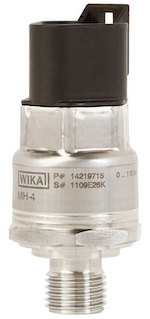Measuring instruments from WIKA undergo extensive in-house testing throughout their development cycle and beyond. This commitment to rigorous, impartial testing allows us to stand behind our claims of performance, durability, and reliability.
The data sheet for every WIKA measuring instrument contains a list of specs attesting to its accuracy, performance, and durability. But how do we back up those claims? With lots and lots of product testing, the vast majority of which is done in-house.
WIKA’s Comprehensive Quality Testing
We are passionate about product testing, so much so that we have our own certified labs dedicated to this function. These state-of-the-art facilities follow – and often exceed – national, regional, and global standards for safety and performance, and our testing experts are committed to impartiality.
What’s more, testing is not a one-time event at WIKA, but occurs from benchtop until shipping – and beyond.
1. Prototyping
Our engineers love having a testing lab right on the premises. During the R&D phase, they are able to create a prototype, get immediate feedback on its performance, and then fine-tune the parameters. This reconfigure-and-retest process continues until the new model meets WIKA’s high standards and expectations.
2. Material quality
WIKA tests more than just products. When raw materials and components arrive at our facilities, our labs inspect and verify their quality before they hit the factory floor.
3. Production
Once prototyping is complete and the materials are controlled for quality, it is time to assemble the sensors. Even during the manufacturing stage, our test labs are busy, pulling random samples to check the instrument’s construction, mechanics, and sensor technology.
4. Release
This is the stage where WIKA devotes the most time and attention. After a batch comes off the assembly line, we put large quantities of a particular sensor through the paces via sequential and parallel testing of its electronics, mechanics, and environment. This is one aspect of determining a product’s PPM (parts per million defective) rating. WIKA proudly sets high quality standards with low PPM targets.
5. Audits and service
Lastly, our test labs conduct annual audits on our sensors to ensure the quality of our instruments. And in the rare case of defects, we use scanning electron microscopes, digital microscopes, and other advanced equipment to analyze the product and determine the cause of the problem.
Testing is an essential part of our company’s DNA. We have a motto when it comes to quality assurance: It is better to test too much than too little. Watch this short video for an introduction to WIKA’s commitment to the highest quality standards via in-house testing.
MH-4: A Thoroughly Tested Pressure Sensor
An extensive battery of tests proves that the heavy-duty MH-4 OEM pressure sensor for mobile working machines has the reliability and performance that we claim in the data sheet.
- Load change tests: pulsation and pressure spikes, load cycle, overload, etc.
- Vibration and shock tests: random and continuous vibrations, single and continuous shocks, free falls, etc.
- Temperature tests: dry heat, constant humidity, fast temperature cycling, rapid temperature changes, condensation, low/high temperature ranges, etc.
- Ingress protection tests: dust, water immersion, high-pressure water jets, etc.
- Environmental and mechanical resistance tests: electrical connector pull-off test, case and socket torque, case strength, impact test, solar radiation, salt spray test, icing, chemical resistance, corrosive gas testing, humidity, low-temperature storage, etc.
- Electrical tests: voltage drops and changes, load dump, overvoltage protection, short-circuit resistance, reverse polarity protection, switch-on time, signal noise, diagnostic functions, long-term drift and stability, line interruptions, etc.
- EMC tests: emitted interference, immunity high frequency, immunity electrostatic discharge, immunity magnetic fields, etc.
This is a pressure sensor ideally suited for extreme environments. Beyond its proven quality and heavy-duty construction, the MH-4 offers OEMs a host of user-friendly advantages:
- Numerous configurations and interfaces for easy integration into production lines and machine platforms
- Compact design (about 2 inches/50mm) for a better fit in today’s mobile machines
- Two-wrench system conducive to highspeed manufacturing
- On-board diagnostics for easy troubleshooting in the field
The MH-4 is manufactured on a fully automated line that is continuously monitored for quality. The pressure sensors are thoroughly tested before they are boxed and shipped to customers around the globe.
With all these features and quality assurances, it is little wonder that the MH-4 is the preferred pressure sensor for some of the world’s largest manufacturers of agricultural, construction, mining, and material handling machinery.
WIKA USA, a Trusted Partner for OEMs
The industrial instrumentation specialists at WIKA USA work closely with customers to ensure that our measuring instruments meet their application’s specific requirements. This extends to additional laboratory and field tests, especially for custom or modified products. Contact us to learn more about our rigorous standards for quality.
Product mentioned in this blog:
• MH-4 OEM pressure sensor


